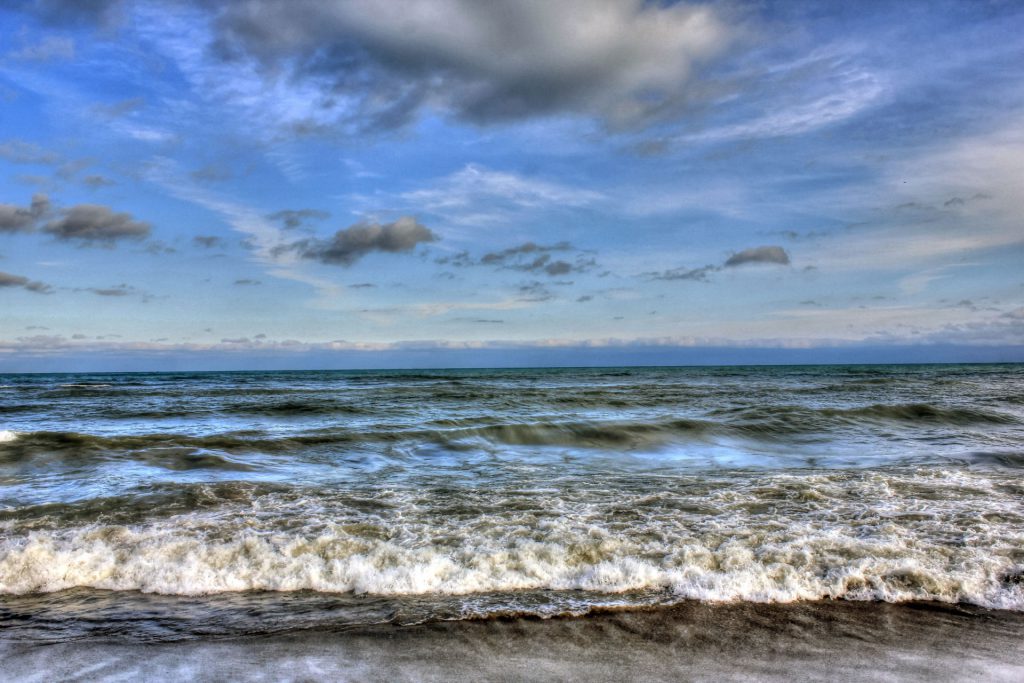Warm Lake Waters Signal Coming Algal Blooms
Conditions are ripe for blooms of harmful blue-green algae.
Surface water temperatures on the Great Lakes have been warmer than average this year, prompting researchers to ask the public to be on the lookout for harmful algal blooms on Lake Superior.
Scientists saw a spike in surface water temperatures earlier this month due to a warm summer and a milder winter on the Great Lakes. Lake Michigan’s average water temperature was roughly 75 degrees — nearly 11 degrees above normal and a record so early in the month.
Temperatures have come down as conditions have returned closer to normal, according to Eric Anderson, a physical scientist with the National Oceanic and Atmospheric Administration’s Great Lakes Environmental Research Lab.
“But, we still have warm water in really most regions of the Great Lakes,” said Anderson.
Researchers who conduct water monitoring in Lake Superior like Robert Sterner, director of the Large Lakes Observatory at the University of Minnesota-Duluth, say the warmer conditions make it more likely for blooms to form. He said that’s why researchers are asking people to help spot them.
“We don’t have the entire lakeshore between Duluth and the Apostle Islands surveyed or monitored,” said Sterner. “So, given the large number of people who typically are recreating around that area, it’s likely that someone from the public will be aware of a bloom before we will.”
Blue-green algae, also known as cyanobacteria, can produce toxins that might make people or animals sick. The first blue-green algae bloom on Lake Superior was reported in 2012 following storms that caused massive flooding in the region. Another large bloom formed in 2018 that spanned roughly 50 miles from east of Superior to the Apostle Islands on the lake’s south shore.
Sterner said it appears the largest blooms have occurred in years with historically large rainfall that often sends a lot of nutrients into the lake. He said they might expect a smaller bloom to form this year without record-setting rains.
Time is of the essence in reporting blooms, according to Brenda LaFrancois, regional aquatic ecologist with the National Park Service.
“Because these blooms are typically transient and short-lived, it’s really important to have lots of eyes on it,” said LaFrancois.
She and a group of researchers who make up an algal bloom response team on the lake are asking people to share the time, size, location and photos of any blooms if they form. Blooms haven’t been reported within the Apostle Islands National Lakeshore or nearshore areas of the lake, but LaFrancois said the species that forms those blooms is lurking under the surface.
“Over the last couple of weeks, we’ve seen the cyanobacteria species that pops up in blooms previously, and so we’ve been keeping an eye on that right now,” she said.
The Wisconsin Department of Natural Resources did receive a report of blue-green algae at the marina in Cornucopia, according to Gina LaLiberte, the agency’s statewide harmful algal bloom coordinator.
“When we’ve seen blooms on Lake Superior in the past, the water has sort of looked like a milky light green color, and that’s because the water is filled with lots and lots of very tiny green particles,” said LaLiberte. “So that’s really what we’re looking for.”
So far, blue-green algae blooms that have occurred on the lake haven’t produced toxins that can harm people or their pets.
“We don’t have any evidence as of now that these blue-green algae are toxic,” said Sterner. “That said, we strongly discourage people from coming into contact with these blooms, because the type of algae that we’re observing in Lake Superior can be toxic at times. So, if people see green water, they should stay away from it.”
Despite the lack of toxicity, Sterner fears what the formation of blooms may do to Lake Superior’s reputation as a cold, pristine water resource, possibly impacting tourism in the region.
The shallow bay receives a lot of sediments that flow in from surrounding tributaries, making it a seemingly likely space for blooms to form. But, Hudson said that hasn’t been the case.
“We’re also trying to look into the role that sediment plumes that get dumped into Lake Superior and Chequamegon Bay following rain events play in either promoting bloom growth or maybe inhibiting it because of the chocolate-brown water that kind of limits light penetration, and, of course, algae needs light to grow,” said Hudson.
Sterner said a graduate student will also be looking at the role sediment plays in the growth of blue-green algae blooms.
“We’ll be doing some incubation studies with sediments in the laboratory to see if they promote algae blooms because that’s a big missing piece of the puzzle for us here,” said Sterner. “We know these big blooms have occurred in years with historic rainfalls, but we right now can’t connect the dots between a rain event and a blue-green (algae) bloom. So, we’re working on it.”
Researchers say the goal is to determine whether steps can be taken to minimize the risk of blooms forming in the lake as climate change has led to a consistent trend of warming temperatures, less ice cover and more frequent, intense storms that contribute to their appearance.
Water monitoring along the lakeshore is expected to run through October although July and August are considered peak bloom season. Researchers are encouraging the public to share anything they think may resemble blue-green algae in Lake Superior by emailing information to DNRHABS@wisconsin.gov.
Listen to the WPR report here.
Warmer Surface Waters On Great Lakes Set Stage For Harmful Algal Blooms was originally published by Wisconsin Public Radio.






















